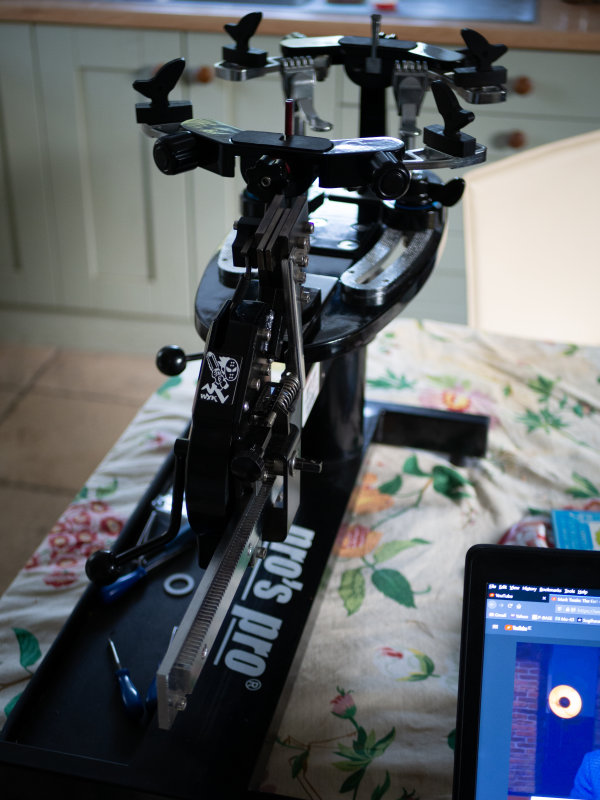bengilmore01
New User
Does anyone have (or had) a pros pro stringer and whats your thoughts on it





Many Pro's Pro machines seem to be identical to some of the Eagnas machines, based on appearance.
I would agree.
Fortunately it sounds like Pro’s Pro doesn’t have the same abysmal customer service that Eagnas owners enjoy (ahem...or not).
I also own one and it's also my first machine!Pro’s Pro Tomcat MT-400 owner here. I’m very happy with it, but it’s my first stringer ever, so I cannot tell you if it’s better or worse than other electronic, linear pull machines.
The machine that sings. A singing machine!This is your culprit on the Comet - this spring under the crank cover likes to sing
I also own one and it's also my first machine!
Do you know how to calibrate it? The "manual" says nothing except spring measures aren't accurate enough and it's calibrated in the factory, but the Pros Pro tension calibrator I have says it's off by +3kg when set to 25kg. At 10kg it's on the mark. ALSO adding to my confusion is the rackets I've strung don't feel too tight when playing with them but do register as high with racquet tune (not that I trust it much).
Any help would be appreciated.
Thanks, I actually did this yesterday. I bought some digital fish scales and the Pros Pro seems to be on the mark. LESSONS LEARNED: Don't trust Pros Pro spring calibrator or phone apps, lol.Try another measuring tool first. Something digital (they're cheap) perhaps or at least another spring calibrator.
After that, it likely works like many other lockouts as far as calibration. I have a eagnas 910 Combo manual i can send
you and since i think many pro's pro and eagnas machines are "the same" i'd at very least say the tension heads are
the same/similar enough.
it is normal to have very little drawback. i recall @Irvin has a video explaining about that.Follow up question...
I don't know (for lack of experience) if this happens on all machines, but I've noticed that when releasing the string from the tension head (while clamped and locked in) it appears the clamp moves back a few millimeters. What's that all about? It feels really solid when I try to move it while locked with my hand.
(Machine: Pros Pro Tomcat MT-400)
Be very careful adjust a LO machine. The adjust so be made at the instant the LO locks out and not after it settles. If you use the tension after it settle your machine will be adjust to lockout at a tension higher than reference tension. 3-4 lbs sounds about right (depending on the string) for a settled tension.Dear all, I have just bought a Comet crank machine (used) but the tension is slightly out by 3-4lbs across the range. I can't work out how to adjust the tension head from the brochure. Does anyone have any experience of this? All tips & advice appreciated.
Cheers
David
You can also tension the same piece of string say 10 times. That way the "plastic elongation" will be removed, and only the elastic elongation remains, which gives an "almost" reliable measurement of the lock-out tension.If you use the tension after it settle your machine will be adjust to lockout at a tension higher than reference tension. 3-4 lbs sounds about right (depending on the string) for a settled tension.
Plastic / elastic, it does not matter. You could use a rubber band if will hold the tension. You should make an immediate measurement at lock out and not give the string time to stretch. The reason you want an immediate is because different string relax at a different rate. If you make measurement after it settles for 10 seconds it will not be the same for all strings.You can also tension the same piece of string say 10 times. That way the "plastic elongation" will be removed, and only the elastic elongation remains, which gives an "almost" reliable measurement of the lock-out tension.
Plastic / elastic, it does not matter.
Well from your posts you make now, you must be stringing with a crank. Big change from your stringway that you praise ad nauseum.I does matter!
Maybe I used the wrong term: with "plastic elongation", I meant "lasting elongation" . The elongation that "lasts" when the pulling tension is discontinued. When you pull tension with a crank 10 times, you have removed almost all "lasting elongation" (relevant to that specific ref.tension); then you will have only the "elastic elongation", and you will notice that after lock-out, the tension hardly will drop.
@Irvin , you state one thing, and then you show a video that "proves" my point. Pulling 2 or 3 times on a crank removes the loss of tension caused by the lasting elongation (elastic elongation is unchanged.)Never did I ever say you should pull 2 or 3 time to remove plastic or elastic elongation.
.Constant pull machines do not remove all plastic or elastic elongation.
I'm also thinking about buying the Tomcat, would love to hear everything about the machine from someone with first-hand experience.Hi all, I’m considering to purchase PP Tomcat standalone stringing machine...I’m a beginner.
Are there any nice videos to see how the whole stringing process could be done with Tomcat?
Thanks!
